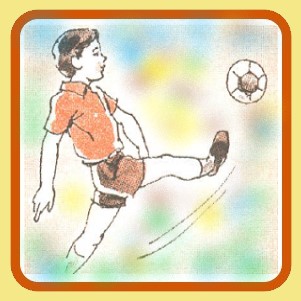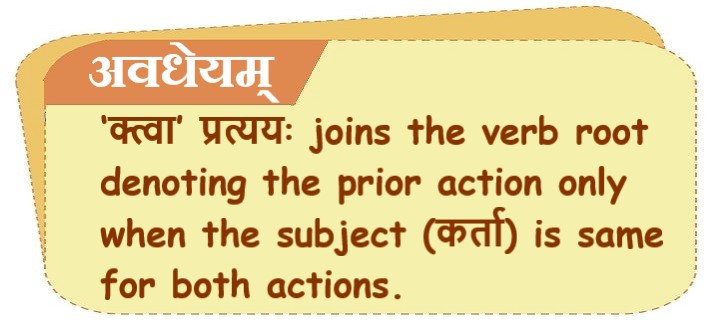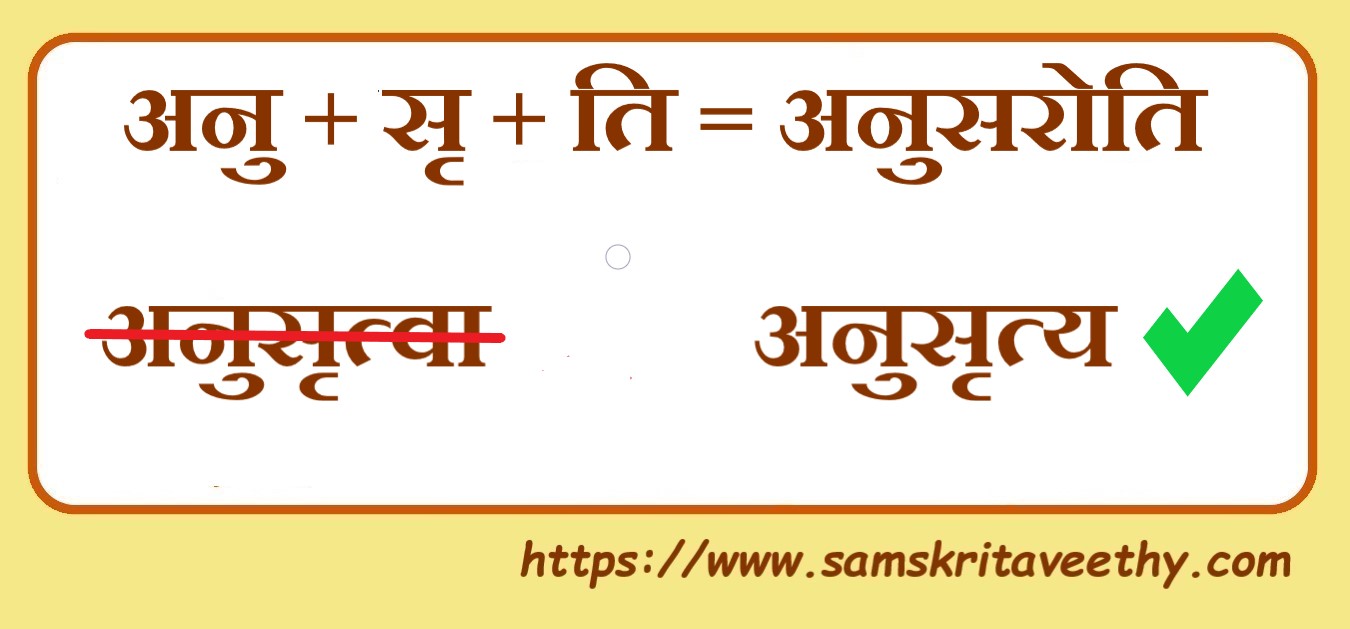 | We learn about........ | |
| We have so far learned in this module... |
|
| The goal of this lesson is to learn ….. |
|
Click the heading to view the video. क्तवतु forms like गतवान्, कृतवान्, प्राप्तवान् and their plural forms are practiced in the Sambashana Video linked to this lesson. The video also introduces some Avyaayas. The first half of the video covers indeclinable forms ‘च’ and ‘अतः’.
| Conversation Practice - सम्भाषणाभ्यासः | |
|---|---|
| अहं रामायणं, महाभारतं, भगवद्गीतां च पठामि। | |
| लेखनीं करवस्त्रं च आनयतु। | |
| भवन्तः किं किं खादन्ति? | अहम् अन्नं पायसं लड्डुकं च खादामि। |
| भवन्तः किं किं कुर्वन्ति? | अहं श्रवणं क्रीडनम् अध्ययनम् च करोमि। अहं पठनं नृत्यं योगाभ्यासं च करोमि। |
| भवतः/भवत्याः गृहे के के सन्ति? | मम गृहे माता पिता भ्राता च सन्ति। |
| भवन्तः कां कां भाषां जानन्ति? | अहं संस्कृतं, कन्नट-भाषां, हिन्दी-भाषां आङ्ग्लभाषां च जानामि। |
| भवन्तः किं किं दृष्टवन्तः? | अहं दिल्हीनगरं चेन्नैनगरं उज्जय्नी नगरं च दृष्टवान्। |
| अतः शब्दः | |
| पिपासा अस्ति। अतः जलं पिबामि। | बुभुक्षा अस्ति। अतः भोजनं खादामि। |
| वाहने इन्धनं नास्ति। अतः वाहनम् न चलति। | अहं विज्ञानी। अतः अहं संशोधनम् करोमि। |
| गोपालः रुग्णः अस्ति। | अतः सः शालां न गच्छति। |
| अतः सः वैद्यालयं गच्छति। | |
| अतः सः निद्रां करोति। | |
| अतः सः न क्रीडति। | |
We have learned in Lesson 12 the use of क्तवतु प्रत्ययः belonging to ‘कृत् प्रत्ययाः’ group. क्तवतु forms indicate actions performed in the past. In this lesson we learn the forms and use of another ‘कृत् प्रत्ययः’ known as ‘क्त्वा’.
Please look at the pictures and the sentences given below to explain the happenings.
 |  |
| बालकः स्नाति। | बालकः नमति। |
| बालकः स्नात्वा नमति। Boy prays after bathing. | |
 |  |
| बालकः विद्यालयं गच्छति। | बालकः पठति। |
| बालकः विद्यालयं गत्वा पठति। Boy reads after going to School. | |
 |  |
| बालकः क्रीडति। | बालकः खादति। |
| बालकः क्रीडित्वा खादति। Boy eats after playing. | |
Look at the pattern in the above sentences. An action takes place after the completion of another action. When the two actions are combined in one sentence, the word indicating the first action assumes a form different from the main verb form. These forms are known as ‘पूर्वकालिकाः’ as they indicate the occurrence of a Kriya prior to the main Kriya in the sentence. The form used to represent the पूर्वकालिका क्रिया is achieved by adding ‘क्त्वा’ प्रत्ययः to the verb root. Unlike the क्तवतु forms क्त्वान्ताः are indeclinable forms (अव्ययः). That is their forms do not change according लिङ्गम्, वचनम् or विभक्तिः।
‘क्त्वा’ प्रत्ययः is often referred to as त्वा प्रत्ययः as the leading ‘क्’ is dropped in usage.

‘क्त्वा’ Forms of some commonly used dhatus are given below in the table. Similar forms are grouped together for easy recognition of the pattern. ‘Click Here’ to download the pdf file.
| लटि | क्त्वान्तः | लटि | क्त्वान्तः |
|---|---|---|---|
| हसति (हस्) | हसित्वा | धरति (धृ) | धृत्वा |
| क्रीडति (क्रीड्) | क्रीडित्वा | करोति (कृ) | कृत्वा |
| भ्रमति (भ्रम्) | भ्रमित्वा | स्मरति (स्मृ) | स्मृत्वा |
| जपति (जप्) | जपित्वा | हरति (हृ) | हृत्वा |
| लिखति (लिख्) | लिखित्वा | शृणोति (श्रु) | श्रुत्वा |
| खादति (खाद्) | खादित्वा | ||
| खनति (खन्) | खनित्वा | जानाति (ज्ञा) | ज्ञात्वा |
| क्रन्दति (क्रन्द) | क्रन्दित्वा | स्नाति (स्ना) | स्नात्वा |
| धावति (धाव) | धावित्वा | ||
| निन्दति (निन्द्) | निन्दित्वा | क्रीणाति (क्री) | क्रीत्वा |
| नृत्यति (नृत्) | नर्तित्वा | नयति (नी) | नीत्वा |
| पठति (पठ्) | पठित्वा | भवति (भू) | भूत्वा |
| पतति (पत्) | पतित्वा | ||
| मिलति (मिल्) | मिलित्वा | पिबति (पा) | पीत्वा |
| तिष्ठति (स्था) | स्थित्वा | दहति (दह्) | दग्ध्वा |
| गच्छति (गम्) | गत्वा | पश्यति (दृश्) | दृष्ट्वा |
| नमति (नम्) | नत्वा | पृच्छति (प्रच्छ्) | पृष्ट्वा |
| कर्षति (कृष्) | कृष्ट्वा | ||
| त्यजति (त्यज्) | त्यक्त्वा | इच्छति (इष्) | इष्ट्वा |
| पचति (पच्) | पक्त्वा |
| अध्यापकः पाठं पाठयित्वा प्रश्नान् पृच्छति। | Teacher asks question after teaching the lesson. |
| मयूरः मेघं दृष्ट्वा नृत्यं करोति। | Peacock dances looking at the Clouds. |
| त्वं चिन्तयित्वा उत्तरं लिख। | You write the answer after thinking. |
| सः गृहपाठं कृत्वा शयनम् करोति। | He goes to sleep after doing the Home Work. |
| अहं दुरभ्यासं त्यक्त्वा सज्जनः भवामि। | I become a good man giving up the bad habits. |
| विक्रेता पुस्तकं दत्त्वा धनं स्वीकरोति। | Sales man takes the money after giving the book. |
| शिशुः जननीं स्मृत्वा रोदनं करोति। | Child cries after remembering the mother. |
| क्रीडापटुः क्रीडित्वा विश्रामं करोती। | Sportsman takes rest after playing. |
| पिता मन्दिरं गत्वा देवं नमति। | Father prays after going to temple. |
| मुनिः वनं गत्वा ध्यानं करोति। | Saint meditates after going to the forest. |
We have provided exercises on the use of ‘क्त्वा’ in indicating the prior action at the end of the lesson.
We have learned in Lesson 11 about the role of Prefixes (उपसर्गाः) in modifying the meaning of a verb. ‘क्त्वा’ प्रत्ययः is added to a root verb (धातुः) when it is not preceded by a उपसर्गः. ‘ल्युप्’ प्रत्ययः is used to indicate the previous action when an Upasarga is appended.
सीता रामम् अनुसरति। सीता वनं गच्छति।
सीता रामम् अनुसृत्य वनं गच्छति।
We can clearly see the different form of ‘पूर्वकालिका’. It is not ‘अनुसृत्वा’ following the ‘क्त्वा’ pattern but ‘अनुसृत्य’.

The initial ‘ल्’ and the final ‘प्’ of ‘ल्यप्’ are dropped following Anubandha Rules leaving ‘य’ to join the verb root.
The following table shows the matching ‘ल्यप्’ endings formed with ‘उपसर्गाः’ with the corresponding ‘क्त्वा’ endings formed without ‘उपसर्गाः’. "Click here" to download the pdf form of the table.
| क्त्वा-प्रत्ययान्तरूपाणि ल्यप्-प्रत्ययान्तरूपाणि च | |||
|---|---|---|---|
| क्रियापदम् | क्त्वान्तरूपम् | उपसर्गसहितं क्रियापदम् | ल्यबन्तरूपम् |
| गच्छति | गत्वा | आगच्छति | आगत्य |
| नयति | नीत्वा | आनयति | आनीय |
| स्मरति | स्मृत्वा | विस्मरति | विस्मृत्य |
| लिखति | लिखित्वा | विलिखति | विलिख्य |
| क्रीणाति | क्रीत्वा | विक्रीणाति | विक्रीय |
| जानाति | ज्ञात्वा | विजानाति | विज्ञाय |
| स्थापयति | स्थापयित्वा | संस्थापयति | संस्थाप्य |
| प्रेषयति | प्रेषयित्वा | सम्प्रेषयति | सम्प्रेष्य |
| हरति | हृत्वा | संहरति | संहृत्य |
| नमति | नत्वा | प्रणमति | प्रणम्य |
| क्षालयति | क्षालयित्वा | प्रक्षालयति | प्रक्षाल्य |
| कर्षति | कृष्ट्वा | आकर्षति | आकृष्य |
| तिष्ठति | स्थित्वा | उत्तिष्ठति | उत्थाय |
| भवति | भूत्वा | अनुभवति | अनुभूय |
| दिशति | दिष्ट्वा | निर्दिशति | निर्दिश्य |
| करोति | कृत्वा | परिष्करोति | परिष्कृत्य |
| छात्रः कक्ष्यां प्रविष्य उपविष्टवान्। | Student sat after entering the room. |
| अहं लेखनम् परिष्कृत्य प्रेषयामि। | I send the write up after correcting it. |
| सर्वे हस्तान् प्रक्षाल्य भोजनं कुर्वन्तु। | Please all eat after washing the hands. |
| मित्राणि उपविश्य वार्तालापं कुर्वन्ति। | Friends chat after sitting. |
| बालकः क्रीडनं समाप्य गृहं गतवान्। | Boy stopped playing and went home. |
इदानीं क्त्वान्त-लयबन्त-पदान् सम्बन्धिताः अभ्यासाः करवाम। Let us now do some practice exercises on ‘क्त्वा’ and ‘ल्यप्’ forms.
लिखति – लिखित्वा
आगच्छति - आगत्य
We welcome your views and suggestions on this lesson. Please post your comments and replies after registering free. Please also send a mail to samskrit@samskritaveethy.com for any clarification on the lesson.
We have so far learned....
Boy goes to School to study.
She goes to shop to buy fruits.
In the above sentences words like ‘to study’ and ‘to buy’ indicate the intention. What is the form that shows the Intention or Wish in Samskritam? We learn about one more Pratyya ‘तुमुन्’which is used to achieve these forms in our next lesson. The lesson to follow is....
Lesson 18: Word Forms with Suffixes तुमुन् - तुमुन् प्रयोगः
 | 0 comments |
To get updates on
संस्कृतवीथी...